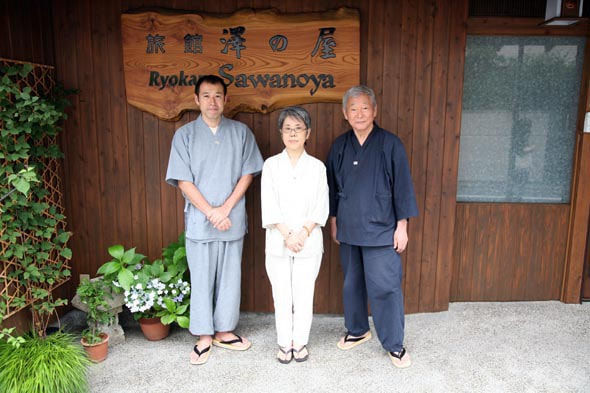
Staff of Sawanoya
Isao Sawa (right), the landlord, Yoneko (his wife) and Arata (his son)
Q: How do tourists who reserve rooms know Sawanoya?
Some of them inquire about our accommodation after hearing form people who have stayed at Sawanoya before. They are also informed that Sawanoya is a B&B style inn, and that they need to have dinner at nearby restaurants. We do not offer excessive service. Guests might enjoy shopping, having dinner, washing clothes and going out in a carefree way.
Q: The iron and the ironing board that are placed in the hallway are interesting.
The coin-operated laundry is convenient to guests. Once some guests said they wanted to use an iron. However, I was a bit concerned about them using an iron in their rooms. At that time, I stayed at a hotel in Finland, and saw an ironing board placed in a hallway. I thought that it is a good idea, so I placed an ironing board in the hallway of Sawanoya. When they iron clothes, they can see the neighboring house's tiled roof and distant views. It is quite popular among them. When they hang clothes on the clothes-drying platform on the roof after washing their clothes, they can see rows of houses in Yanaka, Ueno Park and Tokyo University of the Arts in the distance. It seems the scenery is of interest to them.
Q: Has the scenery of Yanaka significantly changed?
Kan-eiji Temple and nearby Gyokurin-ji Temple have histories of approximately 400 years, so, I think, Yanaka, a temple district, is also as old as those temples. Stores in the neighborhood have been taken over by the second or third generation, so there are no major changes. The Metropolitan Electric Railway was abolished in 1972, so there was no means of transportation for people coming to Yanaka. Nowadays, budget hotels in the Ueno Station area are close to stations, so few tourists come to Yanaka. It might be the reason the scenery of Yanaka has not significantly changed. (continued in the upper right column)
Q: Have you encountered some problems in terms of differences in cultures and practices when guests stay at Sawanoya?
Since some guests do not know how to use a Japanese-style bathroom, English notices are put on the wall. Some English sentences have been revised by guests. My wife and I have visited about 20 countries and traveled to many regions. We have had some problems caused by cultural differences. Through that experience, I think, to some extent, we should accept differences in cultures and practices. Guests from six or seven countries have always stayed at Sawanoya, so we can sense differences in national cultures and practices. For example, guests from Muslim countries pray in a bathroom. We should accept such a practice.
Q: How will hotels and inns change in the future?
In Tokyo, there are a variety of accommodations, including cheap hostels where people can stay for 2,000 to 3,000 yen, shared houses for long-stay travelers, budget hotels, inns like Sawanoya and large hotels, so tourists and business travelers have more choices. Our foreign guests' average duration of travel is 22 days, and they stay in Japan for 15 days on average. The average number of days they stay at Sawanoya is 4 days. According to the statistics by the Ministry of Land, Infrastructure, Transport and Tourism, the average number of days Japanese spend for travel is 1.6 days - that is, less than 2. If foreign tourists travel around Japan, the number of days they stay in Japan will increase significantly. In order to promote tourism in Japan, we should accept not only group tourists but also a variety of travelers, and create an environment in which local and international travelers can easily travel around the country.






